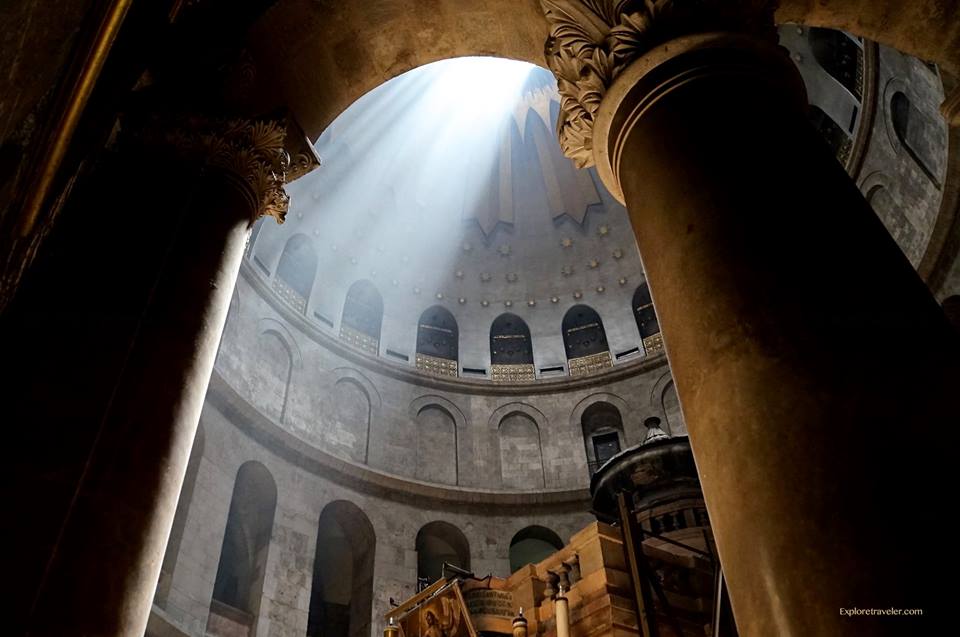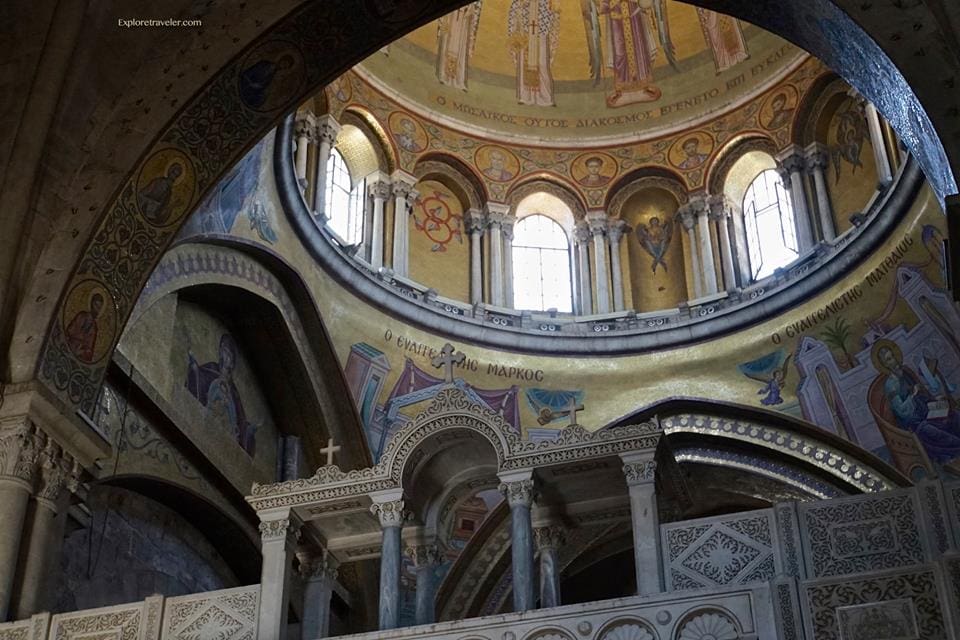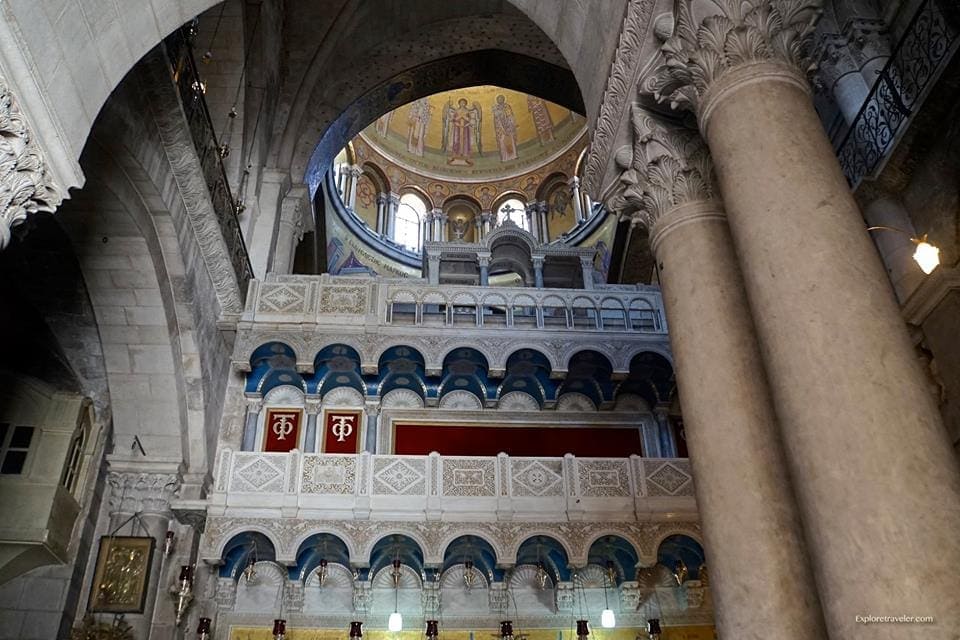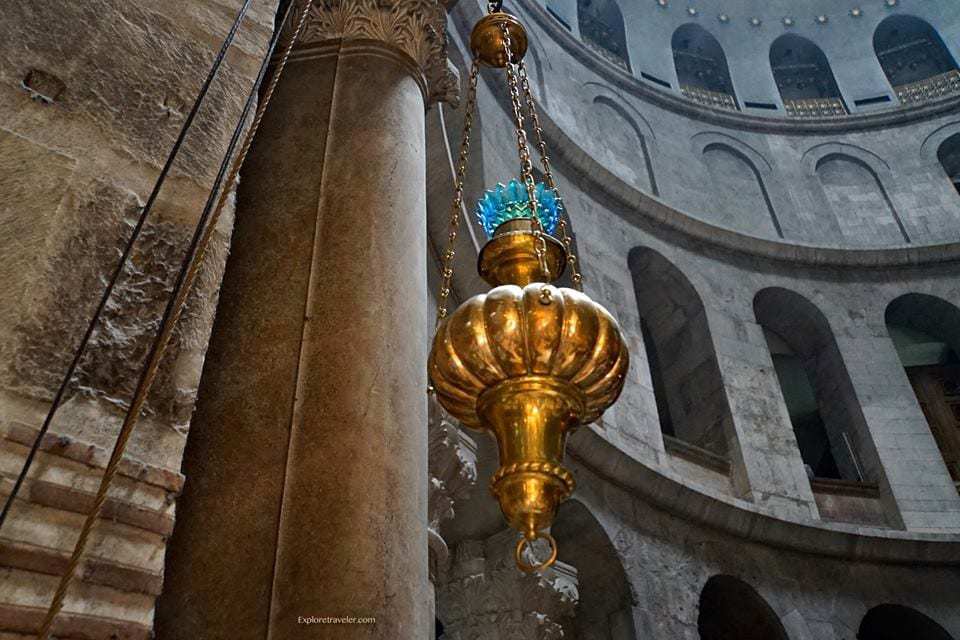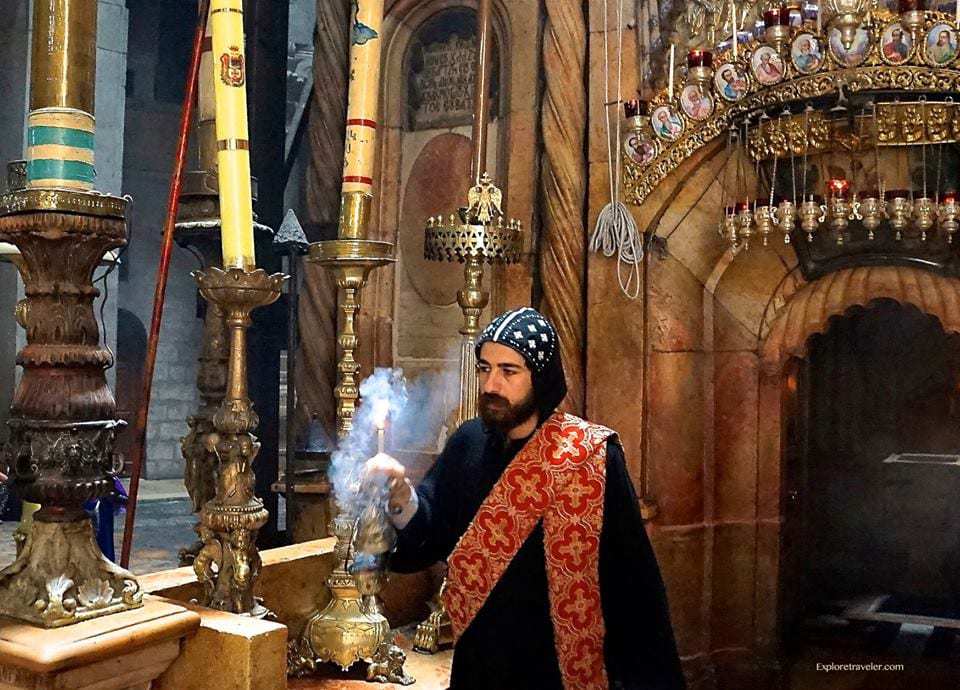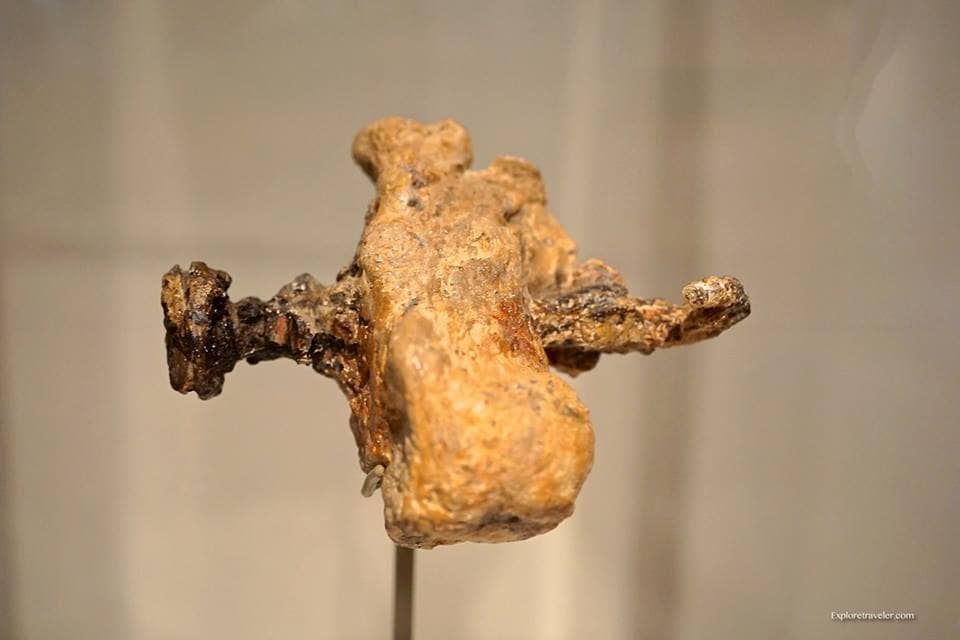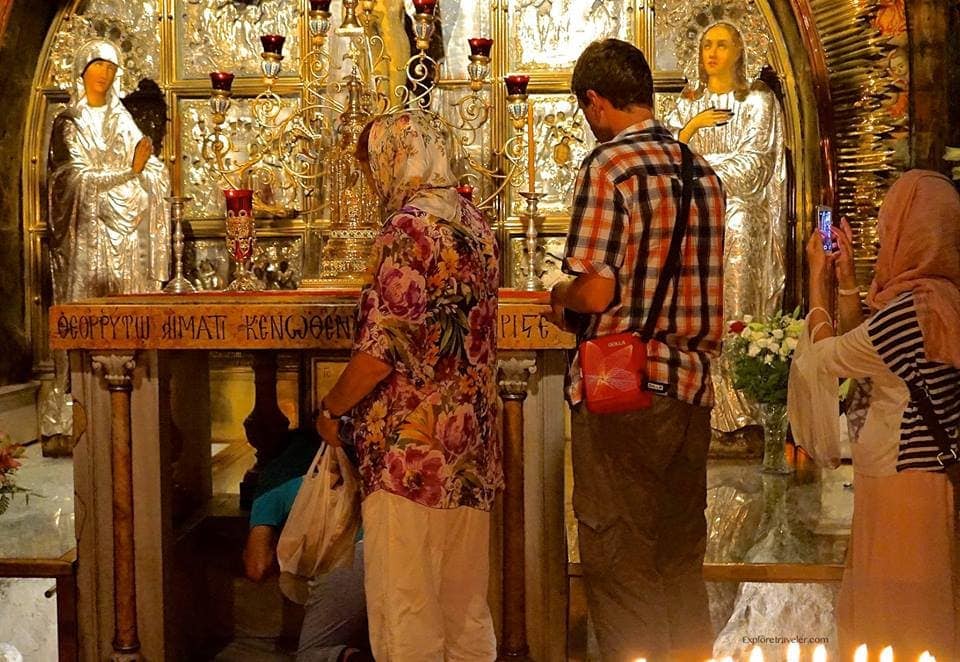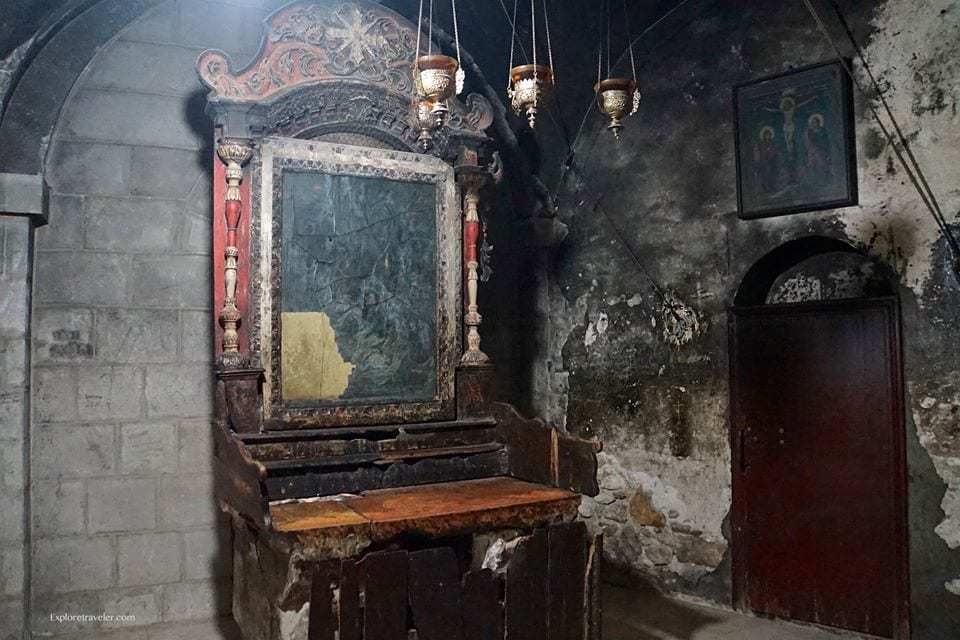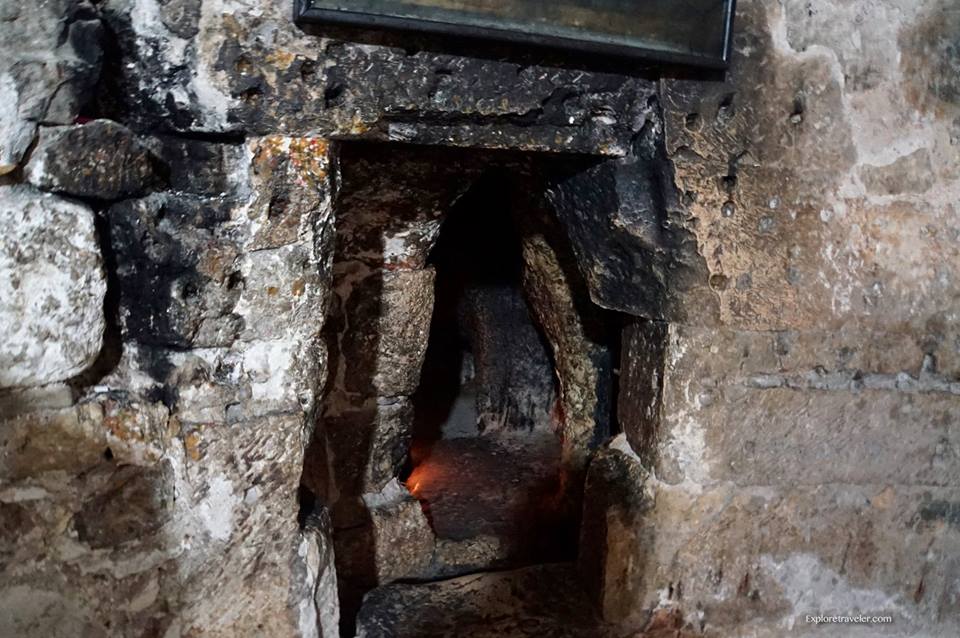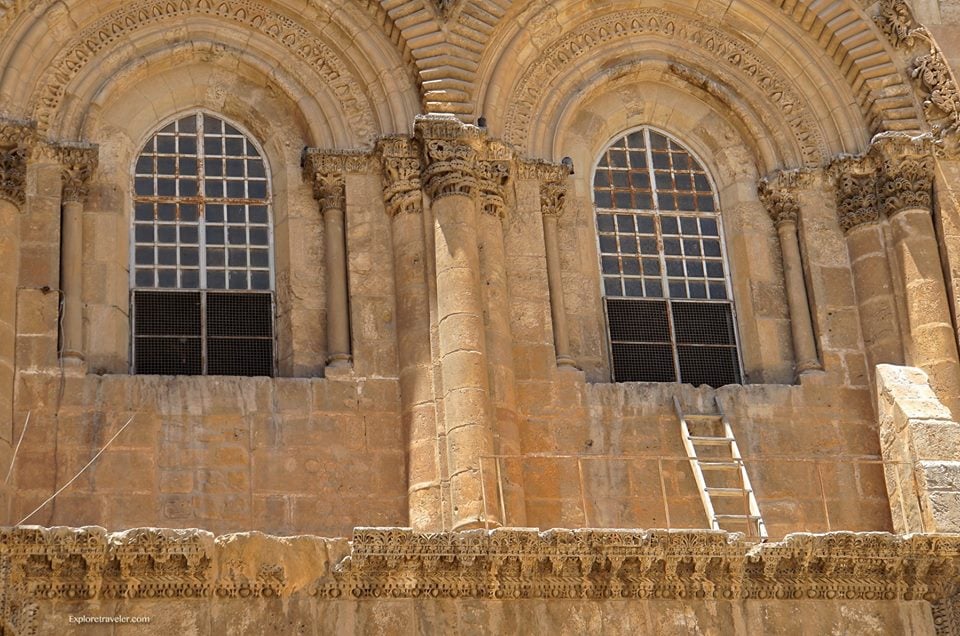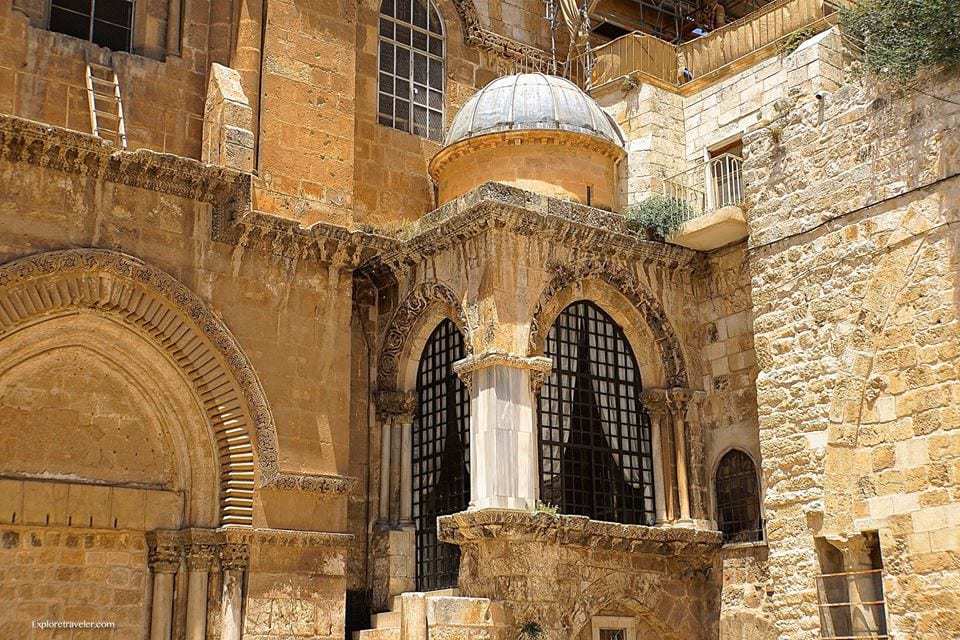Table of Contents
Light Shines In The Darkness At The Church Of The Holy Sepulcher In Jerusalem Israel
What a magnificent sight to see with light shining into the dark church at the very location of the crucifixion of Jesus, The interior of the church is very poorly lite, but coming into the dome were broad rays of light. It is here that His death, burial, and resurrection took place. The church is designed and built over the crucifixion site and the place of His burial and resurrection. The Church Of The Holy Sepulcher site has been recognized since early in the 4th century as the place where Jesus was crucified, buried, and rose from the dead. It is believed that it was here that the Light pierced the darkness.
As a traveler, one can not help but notice the amazing difference in the lighting. It brings you back to that time when the light indeed pierced the darkness. If you are a traveler interested in the local history or culture of the area, or a pilgrim wanting to experience contact with the light, this is a must-see while in Jerusalem.
“And the light shines in the darkness, and the darkness did not comprehend it.”
(KJV John 1:5)
The Inner Beauty Of The Dome
The Church of the Holy Sepulcher is also known among the Eastern Orthodox Believers as the Church of the Resurrection. The Church of the Holy Sepulchre is one of several historical churches within the Christian Quarter. This is a major landmark located inside the walled Old City of Jerusalem. This beautiful building, can be found in the Christian sector of the Old City and is a valuable addition to your itinerary. Christian pilgrims around the world consider it one of the holiest places on earth. The building was built so as to include both Golgotha, the place where Jesus was crucified, and the sepulcher where He was buried and rose again from the dead. This has been a very important destination for the faithful dating clear back to the 4th century. What a marvelous site to behold, one that includes both the cross of His crucifixion and the tomb of His burial.
The dome is beautifully done with many paintings from the eighteen hundreds and some from earlier restorations. It is considered the greatest collection of twelfth-century Crusader artwork in the Middle East. It is generally considered an important destination for visitors to Israel and those who are interested in Middle Eastern art, history, and faith. The spectacular workmanship represents many different renovations. This Basilica was destroyed and rebuilt so many times throughout history. Each time it was rebuilt, some of the antiquities from the preceding church were used in the newer renovation or construction.
Another thing to remember is that it has not always been smooth sailing for this extraordinary church. “Subsequent centuries were not altogether kind to the Church of the Holy Sepulchre. It suffered from damage, desecration, and neglect, and attempts at repair (a significant renovation was conducted by the Franciscans in 1555) often did more damage than good. In recent times, a fire (1808) and an earthquake (1927) did extensive damage.
Not until 1959 did the three major communities (Latins, Greeks, Armenians) agree on a major renovation plan. The guiding principle was that only elements incapable of fulfilling their structural function would be replaced.
The exterior facade of the Church of the Holy Sepulchre, on the east side of the church, was built by the Crusaders sometime before 1180.” (Taken from: http://justfunfacts.com/interesting-facts-about-the-church-of-the-holy-sepulchre/)
The Holy Basilica Dome Showing The Nitches And Amazing Detail
This spectacular dome not only is full of artistic touches, but it acclaimed to be at the very center of the earth.
“Pilgrims and Crusaders believed the site to be the literal center of the earth, based on various biblical references. In Crusader times the actual centre point was determined as the triporticus area, later the domed crossing of the Crusader Church of the Holy Sepulchre. Visitors to the church can then be said to be “at the naval, or centrepoint, of the earth.” ( The Art of one of Christendom’s Holiest Sites by John Stringer)
Another View Of This Elaborate Dome
Notice all the carved niches and the hanging gold incense holders. The Church of the Holy Sepulcher has some of the most ornate fixtures of any basilica in the East. Pictures of saints and holy men line the walls. The lamps and ornamental additions to the dome are all solid gold. Throughout the dome and elsewhere in The Church of the Holy Sepulcher you will find some of the finest art of the Crusader era.
The Church Of The Holy Sepulchre is believed to be the location of the empty burial tomb of Jesus. This is considered by many to be the holiest Christian site in Jerusalem. The Church of the Holy Sepulcher is considered to have one of the largest collections of 12th Century Art done by the Crusaders in the Middle East. Tourists, travelers, and pilgrims consider this a must see for all who show interest in historical art and faith. Much of the history of the area and warfare over the centuries, is depicted in various pieces of artwork.
A Priest Administers The Sacred Incense
The Church Of The Holy Sepulcher is a continued place of meditation and prayer, day and night. Pilgrims come from the world over for the opportunity to pray and experience deep meditation at this Holy site. Priests keep a thick smoke from the incense coming from the altar day and night. This is one of the holiest sites for so many pilgrims the world over.
The use of incense dates back to the time of the second temple and the Jewish use of incense. It is thought by many that it represents the prayers of the faithful ascending to heaven. Incense is also used in rites of purification within the Catholic, Eastern, and Orthodox Churches.
Taking a walk through this Basilica requires careful movement among the many pilgrims. At many times of the year, the pilgrims are almost wall to wall. As you near the altar, the thick incense drifts through the air from the gentle movement of the incense vessels by the priest. The Church Of The Holy Sepulcher is one of the most amazing experiences in the Old City of Jerusalem. The old city is also referred to as the walled city, because of the walls which surrounded this ancient city.
Climbing The Steps To Calvary
Once this was a hill you climbed, but now it is a protected site. As you climb the stone steps that lead to the top where Jesus was crucified, you can not help but be in a somber mood. Crucifixion was a brutal way to die. According to accounts in all the Gospels of the New Testament, Jesus was brought to the “Place of the Skull” to die by Crucifixion. He was crucified between two thieves, criminals, but his only charge was claiming to be the “King of the Jews.”
This climb up to Calvary is on the major route for Christian pilgrims of many faiths. The Church Of The Holy Sepulcher is the Holiest site in the Old City of Jerusalem. The church protects both the place of the Crucifixion and the place of the resurrection.
Nail Driven Through The Ankle Bone Discovered In Jerusalem From The 1st Century A.D.
This discovery brings to the pilgrim’s mind and emotions all the horror of the crucifixion. You can not help but feel the pain and agony as you look at this nail through an ankle bone. Crucifixion was the most humiliating of all possible executions. The condemned person was made to be as vulnerable as could be, and usually, they were hung totally naked. Sometimes they could even hang for days just barely alive. This must have been one of the world’s worst form of execution.
In the Forbes Magazine, December 8th, 2015 issue, Khristina Killgrove gives a glance into the significance of this find. She writes: “The Romans practiced crucifixion – literally, “fixed to a cross” – for nearly a millennium. It was a public, painful, and slow form of execution, and used as a way to deter future crimes and humiliate the dying person. Since it was done to thousands of people and involved nails, you’d probably assume we have skeletal evidence of crucifixion. But there’s only one, single bony example of Roman crucifixion, and even that is still heavily debated by experts.”
The Rock Of Golgotha Where Jesus Was Crucified
The rock of Golgotha is believed to be the very place where Jesus Christ was crucified. This place is now protected as a part of the Church of the Holy Sepulcher in the Old City of Jerusalem, Israel. This holy site is venerated as Golgotha, also called the Hill of Calvary, is the place where Jesus was crucified with a thief on each side. The Church of the Holy Sepulcher is also believed by most archaeologists as the place where Jesus was buried in the Sepulcher. According to the biblical accounts, the crucifixion site and the place of his tomb were close.
JOHN 19:41-42
“41 Now in the place where he was crucified there was a garden; and in the garden a new sepulchre, wherein was never man yet laid.
42 There laid they Jesus therefore because of the Jews’ preparation day; for the sepulchre was nigh at hand.”
Though there is some controversy about this site, the Encyclopaedia Britannica has an interesting way of putting some of the pieces together.
“This site has been continuously recognized since the 4th century as the place where Jesus died, was buried, and rose from the dead. Indeed, the Rock of Calvary, where the Crucifixion is believed to have occurred, is encased in glass at the lavish Altar of the Crucifixion and is the most-visited area within the church. Whether it is the actual location, however, has been hotly debated. It cannot be determined that Christians during the first three centuries CE could or did preserve an authentic tradition as to where these events occurred. Members of the Christian church in Jerusalem fled to Pella about 66 CE, and Jerusalem was destroyed in 70 CE. Wars, destruction, and confusion during the following centuries possibly prevented preservation of exact information. Another question involves the course of the second north wall of ancient Jerusalem. Some archaeological remains on the east and south sides of the Church of the Holy Sepulchre are widely interpreted to mark the course of the second wall. If so, the site of the church lay just outside the city wall in the time of Jesus, and this could be the actual place of his Crucifixion and burial. No rival site is supported by any real evidence.” (Encyclopaedia Britannica)
The Stone Of anointing
The Stone of Anointing was the stone where the body of Jesus was laid after being removed from the crucifix and it was here that his body was prepared for burial. This is another one of the holy sites at the Church of the Holy Sepulcher in Jerusalem, Israel. As was the Jewish custom of the time, he was anointed with oils and spices, then he was wrapped in shrouds. This was the common way that all bodies were prepared for burial during this time by the Jews.
“The Stone of the Anointing remains a very holy pilgrimage site for Christians today. Pilgrims queue to either kiss the stone or rub it with oil or rosewater and then wipe it with a cloth. Priests burn incense around the stone and sometimes people place their own crosses on it in order to transfer the unction or anointing.”( History of the The Stone of the Anointing is taken from the website: (https://www.thesalvationgarden.org/the-stone-of-the-anointing/.)”
“Rosewater is used to anoint the Stone of the Anointing because it is a perfume that has traditional use in a number of religions. For example, during Muslim burials rosewater is sprinkled into a grave before burial. Rosewater has in the past been used for the embalming of bodies as it has properties that are good for the skin.”( History of the The Stone of the Anointing is taken from the website: https://www.thesalvationgarden.org/the-stone-of-the-anointing/.)”
“Over hundreds of years, there have been stories of miracles and cures experienced by people who have visited and anointed the Stone of the Anointing. The atmosphere in the Church of the Sepulchre is one of reverence and worship. This is clearly one of the holiest places and somewhere that each and every one of us should consider visiting during our lifetimes.” ( History of the The Stone of the Anointing is taken from the website: https://www.thesalvationgarden.org/the-stone-of-the-anointing/.)”
Syrian Orthodox Chapel In The Church Of The Holy Sepulcher
The Syrian Orthodox Chapel of the Jacobite sect is located just behind the tomb where Jesus was buried. Due to the poverty of the Syrian Orthodox Church, little repairs or restoration has been done to the chapel area. The chapel is located within the church walls of the Constantine Church, all of which are a part of the Church of the Holy Sepulcher in Jerusalem today. The walls and altar sustained major fire damage over the years and no repairs have been made. To the south of the chapel, you will find many typical Jewish tombs of the 1st century. According to tradition, the tombs of Joseph of Arimathea and Nicodemus are found in this area. It was Arimathea who took down the body of Jesus from the cross and saw to the proper burial.
“Luke 23:50-56 King James Version (KJV)
50 And, behold, there was a man named Joseph, a counselor; and he was a good man, and a just:
51 (The same had not consented to the counsel and deed of them;) he was of Arimathaea, a city of the Jews: who also himself waited for the kingdom of God.
52 This man went unto Pilate and begged the body of Jesus.
53 And he took it down, and wrapped it in linen, and laid it in a sepulcher that was hewn in stone, wherein never man before was laid.
54 And that day was the preparation, and the sabbath drew on.
55 And the women also, which came with him from Galilee, followed after, and beheld the sepulcher, and how his body was laid.
56 And they returned, and prepared spices and ointments, and rested the sabbath day according to the commandment.”
Interior Of The Tomb Of Joseph Of Arimathea
Inside the Syrian Orthodox Chapel of Saint Joseph of Arimathea and Saint Nicodemus is a very plain rock hewed cave where Jesus was laid to rest. It is here that the women returned on the First Day of the week to find Jesus was not where he had been placed. Instead, the rock which covered the entrance was rolled aside and Jesus was no longer there.
“Matthew 28:1-7 King James Version (KJV)
28 At the end of the Sabbath, as it began to dawn toward the first day of the week, came Mary Magdalene and the other Mary to see the sepulcher.
2 And, behold, there was a great earthquake: for the angel of the Lord descended from heaven, and came and rolled back the stone from the door, and sat upon it.
3 His countenance was like lightning, and his raiment white as snow:
4 And for fear of him, the keepers did shake and became as dead men.
5 And the angel answered and said unto the women, Fear not ye: for I know that ye seek Jesus, which was crucified.
6 He is not here: for he is risen, as he said. Come, see the place where the Lord lay.
7 And go quickly, and tell his disciples that he has risen from the dead; and, behold, he goeth before you into Galilee; there shall ye see him: lo, I have told you.” (1. Matthew 28: 1-7 KJV)
The National Geographic Magazine October 31, 2016 issue in the article: “Unsealing of Christ’s Reputed Tomb Turns Up New Revelations” by Kristin Romey gives fresh insight into the condition of the tomb today.
“JERUSALEM Researchers have continued their investigation into the site where the body of Jesus Christ is traditionally believed to have been buried, and their preliminary findings appear to confirm that portions of the tomb are still present today, having survived centuries of damage, destruction, and reconstruction of the surrounding Church of the Holy Sepulchre in Jerusalem’s Old City.
The most venerated site in the Christian world, the tomb today consists of a limestone shelf or burial bed that was hewn from the wall of a cave. Since at least 1555, and most likely centuries earlier, the burial bed has been covered in marble cladding, allegedly to prevent eager pilgrims from removing bits of the original rock as souvenirs.
When the marble cladding was first removed on the night of October 26, an initial inspection by the conservation team from the National Technical University of Athens showed only a layer of fill material underneath. However, as researchers continued their nonstop work over the course of 60 hours, another marble slab with a cross carved into its surface was exposed. By the night of October 28, just hours before the tomb was to be resealed, the original limestone burial bed was revealed intact.”
Scaffolding On A Large Unmarked Wall
Possibly a large stone is contained in the scaffolding on this large unmarked wall that might have been part of an earlier altar. This may have been a part of an archaeology project headed by the Greek Orthodox, under whose control that section of the building remains. Any work, that might have been done, seems to have halted. This project possibly dates back into the 1960s, when there was a major project started that was never completed.
There are often unknown digs that go on in different areas of the Church of the Holy Sepulcher due to the shared status of the building and the distrust that can sometimes be seen. The Greek Orthodox, Roman Catholics, Coptic’s, Syrians, and Armenians, all share guardianship of this beautiful piece of history. The Ethiopians have a monastery on the roof and control that area. Two Muslim families keep the keys to the massive Crusader doors. This enables all to have complete access when desired.
The Ladder Window
The mystery of the Ladder Window is one that is centuries old. In fact, the ladder has been there so long, that people no longer even know how it got there or what it was used for. Over the centuries there have been many suggestions put forth, but all are just an attempt to solve an unsolvable mystery.
One that many people have offered is that it was left behind by a careless mason, or window washer. With a building of this size, that certainly is a very real possibility. But then, there is the suggestion of it having been used in order to supply food to the Armenian monks who were locked in the church by the Turks. No matter the reason for the original ladder, it did come in handy for the monks wishing to use the cornice as a balcony to get fresh air and sunshine. By not leaving the church, they were able to bypass paying the Ottoman tax to re-enter through the door.
The ladder appears in an engraving of the church that was done in 1728 and is mentioned in the work of Sultan Abdul Hamid I in 1757. No matter when it was originally left in that position, it is immovable and it is part of the Status Quo. It must permanently remain in its position on the ledge over the entrance to the Church of the Holy Sepulcher. Regardless of when the original ladder was left in this position, it is impossible to think that this is the original ladder that was left behind. Being that it has weathered the elements of Mother Nature since the early 18th century, it would have had to have been replaced at least once. The ladder, window, and the historical cornice are all included as part of the possession of the Armenian Orthodox Church and must so remain.
The Magnificent Church Of The Holy Sepulcher In Jerusalem Israel
Any time of the year is the perfect time to visit the Holy Land. There is always more to see and do than the time you have. If you enjoy history, you will enjoy all the museums and archaeological sites. There is a vast number of ruins to explore and conquer. A trip to Israel also pairs nicely with a side trip to Jordan. You can easily spend a whole day discovering Petra.
For the Christian believer, the highlight of a spring trip would be to join in with the local Christian Churches as they celebrate the Resurrection Of Jesus. Information on the events being held during Holy Week can be found by calling a local Cathedral. The Church of the Holy Sepulcher is very involved in the different Holy Week events. Each of the many denominations, your travel guide, and even your motel can suggest many places to go during this special week.
Those of the Jewish faith will delight in the events surrounding the Passover. A quick call to any of the Chabad Houses will give you all the information needed. Chabad also has a special seder service throughout the Holy Land for those who are traveling, and lack local contacts.
Regardless of your reason or interests, there is never a moment without something to see or do. Jerusalem is an amazing city that you will want to spend as much time as possible. Why not make this the year, you celebrate the events surrounding Easter or Passover in the holy city of Jerusalem, Israel?
GENERAL INFORMATION
Special Holy Week Events
“Palm Sunday procession on the Mount of Olives
Join the popular reenactment of Jesus’ Triumphal Entry into Jerusalem. Participants gather at the Church of Bethpage and begin at 2:30 pm to descend the Mount of Olives, singing hymns and bearing palm fronds.
The Church of the Holy Sepulchre
The Armenians, Copts and Syrians make three rounds around the rotunda in the Church of the Holy Sepulchre. The Palm Procession starts at 7:00 am, and the daily procession begins at 5:00 pm.” (The Official Jerusalem Travel Site)
Holy Thursday Events
“The washing of the feet is a tradition in imitation of Jesus washing his disciples’ feet.
Church of the Holy Sepulchre
8:00 am — Pontifical Mass (Supper of the Lord & Mass of the Chrism), Procession of the Blessed Sacrament
In and around the Old City
3:10 pm — Pilgrimage from St. Savior’s Church (from the entrance from St. Francis Street) to the Cenacle, St. James and St. Mark followed by service with the Washing of the Feet
9:00 pm — Holy Hour in different languages at the Garden of Gethsemane on the Mount of Olives followed by private prayer in silence.” (The Official Jerusalem Travel Site)
Good Friday
“7:15 am — Celebration of the Passion of Christ on Calvary in the Basilica of the Holy Sepulchre
12:15 pm — Procession of the Way of the Cross at the Via Dolorosa with the Franciscan Fathers
8:10 pm — “Funeral Procession” in the Basilica of the Holy Sepulchre
The Garden Tomb
For Protestants, there is a Good Friday meditative service (English) at the Garden Tomb.”
Holy Saturday
The Church of the Holy Sepulcher
6:30 am — Easter Vigil
3:30 pm: Entry and solemn procession
6:00 pm — Solemn Vespers the Holy Tomb
11:30 am (Sunday) — Pontifical celebration of the Liturgy of the Hours at the Altar of Mary Magdalene, presided by the Custos of the Holy Land
Late Saturday night is the Holy Fire ceremony. Thousands await the miraculous lighting of the Patriarch’s candle from within the tomb. Caution is advised since the crowds tend to be tight and there has been violence in recent years.” (The Official Jerusalem Travel Site)
The Church of the Holy Sepulchre Easter Service
10:00 am — Entry of the Latin Patriarch, H.B. Fuad Twal
10:30 am — Pontifical mass and procession
5:00 pm — Daily Procession
The Garden Tomb
Sunrise services in English
Resurrection service in English
8:00 am — Jerusalem Holy Sepulcher: Daily Solemn Mass
10:00 am — Emmaus Qubeibeh: Pontifical Mass & Blessing of bread presided by the Custos
2:30 pm — Emmaus Qubeibeh: Vespers & Exposition of the Blessed Sacrament
5:00 pm — Jerusalem Holy Sepulcher: Daily Procession
MORE SERVICES AND EVENTS
Get the complete schedule for Easter services at both Catholic and Protestant institutions throughout the city by visiting the Christian Information Website.” (The Official Jerusalem Travel Site)
Directions And Information
The Church of the Holy Sepulchre is located in East Jerusalem in between the Jaffa Gate and the Damascus Gate.
Telephone……02/ 627-3314
Visiting Hours: Winter hours
: 4:00 AM – 7:00 PM, Summer hours are: 4:00 AM – 8:00 PM.
Church Of The Holy Sepulcher
References:
- King James Bible
- The Art of one of Christendom’s Holiest Sites by John Stringer
- Forbes Magazine, December 8th, 2015 issue.”This Bone Is The Only skeletal Evidence For Crucifixion In The Ancient World “by Khristina Killgrove.
- Encyclopaedia Britannica, “The Church of the Holy Sepulchre “
- History of the The Stone of the Anointing is taken from the website: https://www.thesalvationgarden.org/the-stone-of-the-anointing/.
- http://justfunfacts.com/interesting-facts-about-the-church-of-the-holy-sepulchre/
- The National Geographic Magazine October 31, 2016 issue in the article: “Unsealing of Christ’s Reputed Tomb Turns Up New Revelations” by Kristin Romey
- The Official Jerusalem Travel Site —– https://www.itraveljerusalem.com/article/easter-in-jerusalem/
The Church of Saint John the Baptist ~ Birth Place Of John The Baptist

